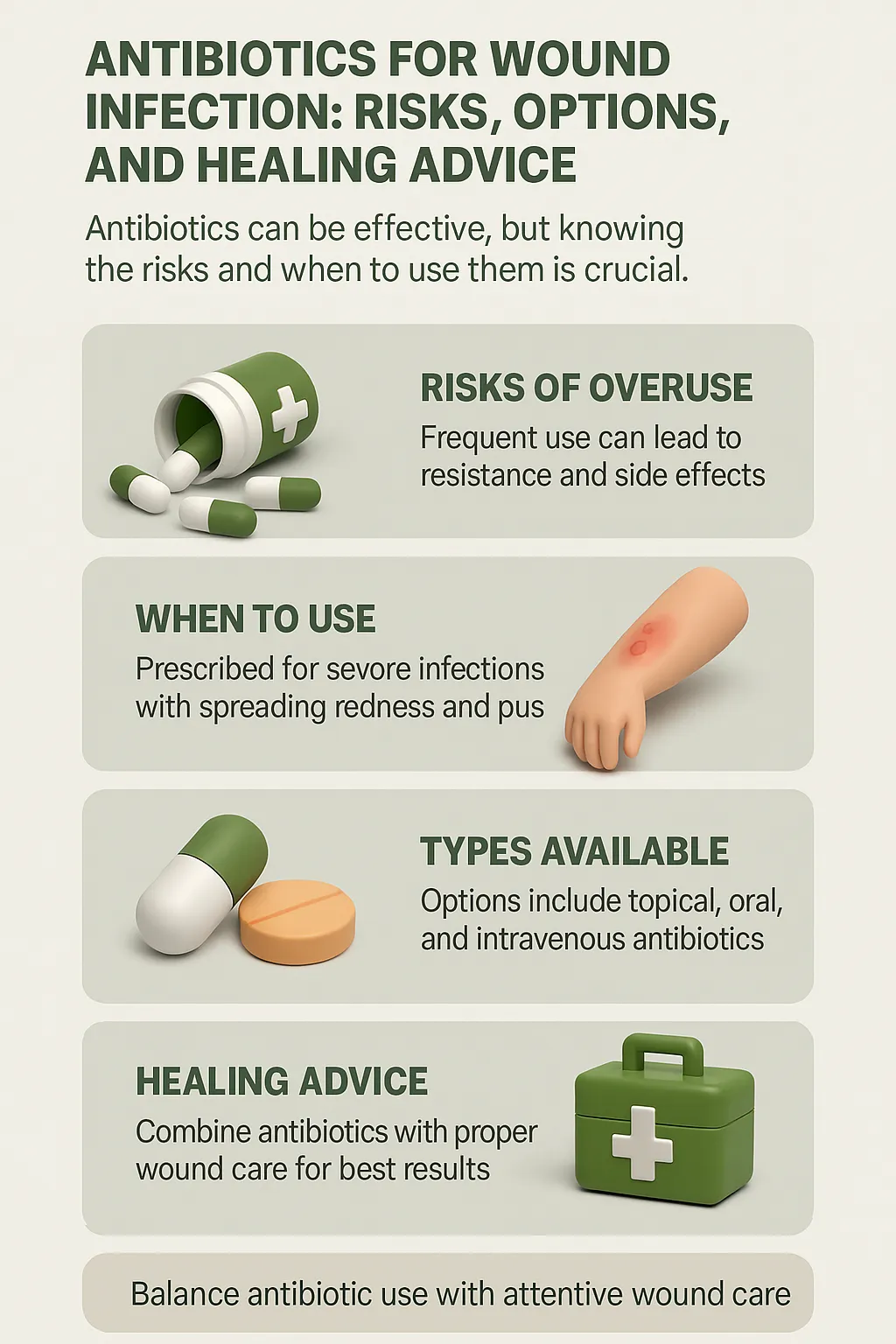If you’ve ever struggled with a wound that became red, swollen, or slow to heal, you’ve probably asked: “What are the risks and options when it comes to antibiotics for wound infection?” The answer isn’t always simple. While antibiotics can be life-saving when infections spread, in many cases careful wound care is enough.
From my clinical experience, I’ve seen antibiotics stop serious infections in their tracks. But I’ve also witnessed cases where unnecessary prescriptions caused side effects or contributed to resistance. The key is knowing when antibiotics are the right choice—and how to pair them with proven wound care practices for the best outcome.
This article explains the potential risks, treatment options, and practical healing advice you need to know about antibiotics for wound infection.
Top Takeaways
- Antibiotics aren’t always needed. Many mild wound infections heal with cleaning and dressings.
- Use antibiotics for serious infections. They’re most effective when infections spread or become systemic.
- Be aware of risks. Overuse can cause resistance, side effects, and delayed recovery.
- Wound care is the foundation. Cleaning, covering, and monitoring speed recovery.
When Antibiotics Are an Option
Antibiotics are highly effective, but not every wound requires them. For many mild infections, proper cleaning, dressings, and daily monitoring work just as well. Doctors usually prescribe antibiotics when wounds show signs of deeper or spreading infection, such as:
- Expanding redness or warmth
- Worsening swelling or tenderness
- Pus or significant drainage
- Fever or whole-body symptoms
When antibiotics are needed, doctors may choose from several options:
- Cephalexin or Dicloxacillin – commonly used for skin infections.
- Clindamycin – effective for resistant bacteria like MRSA.
- Amoxicillin-Clavulanate – prescribed for more complex or mixed infections.
Healing advice:
- Keep wounds clean and covered.
- Watch closely for signs of spreading infection.
- Take the full antibiotic course if prescribed.
- Support recovery with good nutrition, hydration, and rest.
Expert Insight
“In my practice, antibiotics for wound infection work best when carefully matched to the type of bacteria—and always alongside attentive wound care. They are not a cure-all, but a tool used wisely.”
Case Study & Real-World Examples
Minor Cut That Healed Without Antibiotics
Patient: Kitchen knife cut, red but mild.
Treatment: Cleaning + sterile dressings.
Outcome: Fully healed within a week without antibiotics.
Lesson: Not every wound infection requires medication.
Surgical Infection That Needed Antibiotics
Patient: Abdominal surgery recovery with fever and redness.
Treatment: Drainage plus oral antibiotics.
Outcome: Rapid improvement after treatment.
Lesson: Antibiotics are critical when infections spread deeper.
Research + Clinical Balance
Studies show many mild infections resolve with wound care alone.
Antibiotics are most effective for systemic or severe infections.
My experience reflects this balance: some patients heal naturally, while others rely on timely antibiotics.
Patient: Kitchen knife cut, red but mild.
Treatment: Cleaning + sterile dressings.
Outcome: Fully healed within a week without antibiotics.
Lesson: Not every wound infection requires medication.
Patient: Abdominal surgery recovery with fever and redness.
Treatment: Drainage plus oral antibiotics.
Outcome: Rapid improvement after treatment.
Lesson: Antibiotics are critical when infections spread deeper.
Studies show many mild infections resolve with wound care alone.
Antibiotics are most effective for systemic or severe infections.
My experience reflects this balance: some patients heal naturally, while others rely on timely antibiotics.
Supporting Statistics: Why Risks Matter
The CDC reports ~110,000 surgical site infections occur in the U.S. each year.
According to the CDC’s Antibiotic Resistance Report, 2.8 million antibiotic-resistant infections happen annually, leading to 35,000 deaths.
Nearly 30% of outpatient prescriptions are unnecessary, per the CDC’s Outpatient Antibiotic Use Data.
Insight: These numbers confirm the risks of overuse—antibiotics save lives when appropriate, but careful stewardship preserves their effectiveness.
The CDC reports ~110,000 surgical site infections occur in the U.S. each year.
According to the CDC’s Antibiotic Resistance Report, 2.8 million antibiotic-resistant infections happen annually, leading to 35,000 deaths.
Nearly 30% of outpatient prescriptions are unnecessary, per the CDC’s Outpatient Antibiotic Use Data.
Final Thought & Opinion
Antibiotics can be powerful allies in wound healing, but they must be used wisely. I’ve treated patients who healed well without them and others whose lives depended on timely prescriptions.
My perspective:
Prioritize prevention and good wound care.
Turn to antibiotics only when signs of spreading infection appear.
Protect their effectiveness by avoiding unnecessary use.
Key Takeaway: Smart wound care plus careful antibiotic use leads to safer recovery and protects these vital medicines for the future.
Prioritize prevention and good wound care.
Turn to antibiotics only when signs of spreading infection appear.
Protect their effectiveness by avoiding unnecessary use.
Next Steps
Clean & Protect: Wash gently with mild soap, cover with sterile dressings.
Monitor Closely: Look for redness, swelling, pus, or fever.
Take Antibiotics Wisely: Only use when prescribed, and finish the full course.
Support Recovery: Rest, eat protein-rich meals, and stay hydrated.
Consult a Doctor: A medical exam ensures the right treatment.
Clean & Protect: Wash gently with mild soap, cover with sterile dressings.
Monitor Closely: Look for redness, swelling, pus, or fever.
Take Antibiotics Wisely: Only use when prescribed, and finish the full course.
Support Recovery: Rest, eat protein-rich meals, and stay hydrated.
Consult a Doctor: A medical exam ensures the right treatment.




